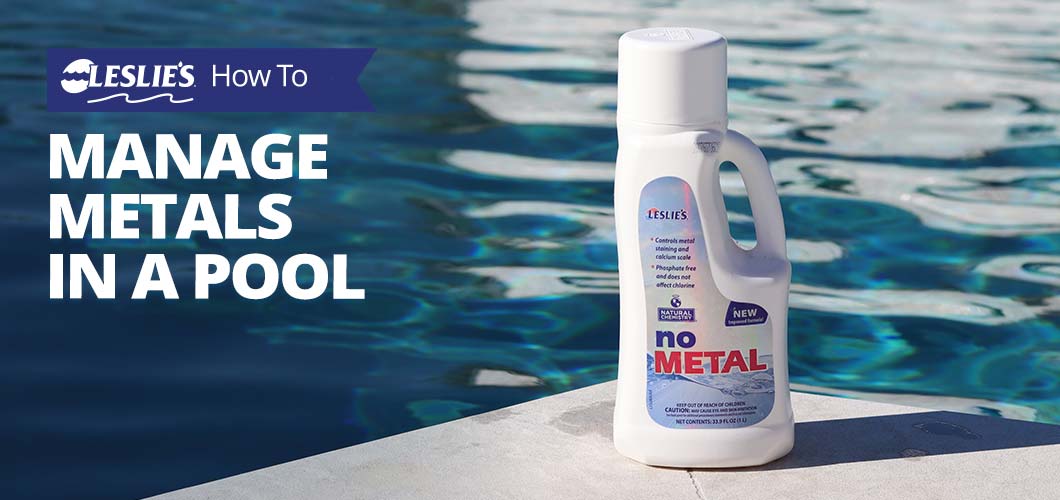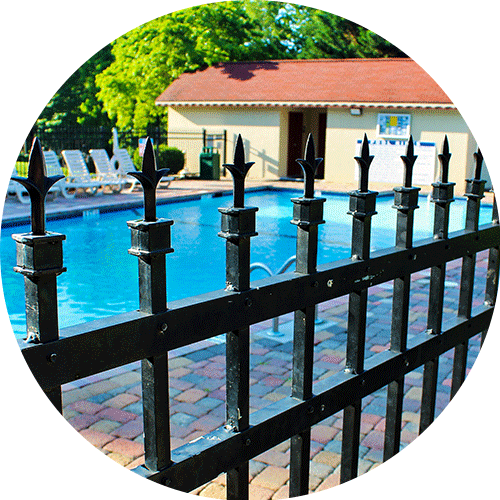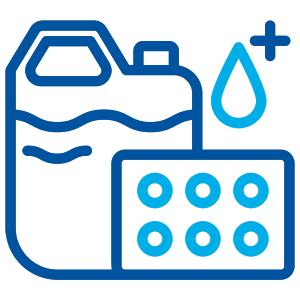
How to Manage Metals in a Pool
Your outdoor swimming pool is exposed to many things during its lifetime. From storm debris to algae, countless contaminants are waiting to sneak their way into the fresh, clean water. Metallic substances are no different. It's very common to have metals in your pool, and typically they don't cause any issues. But when left unchecked and untreated, they can quickly lead to severe, unsightly stains.
Why are There Metals in Your Pool?
All bodies of water, from the ocean to your swimming pool, contain trace amounts of metals. The most common types of metal to find in your pool are iron, copper, calcium, magnesium, and manganese. So where do the metals come from? Well, they come from everywhere! Metals occur naturally in well water and many municipal water sources, which supply your pool with water. Rainwater also contains certain metals which can be deposited into your pool during a storm. Additionally, many pool chemicals, equipment, and structural components of your pool have metal components. And if your water is unbalanced and corrosive, this can cause metals to enter the water.
Metal Mayhem

The presence of metals in your pool water is inevitable, and in small quantities, it's not a problem. As long as the metal content is below 0.2 ppm (parts per million), you're in the clear. Issues arise when that number starts to increase. The most common symptom of an increased metallic presence in your pool is surface staining. Copper and iron, in particular, may cause dramatic discoloration and staining on pool surfaces and near hardware.
Iron stains typically take on a dark brown or red, rust-like shade, and are often caused by using well water to fill your pool. Iron can also be introduced through iron structures like pool fencing, hardware, rebar near the surface of pool walls, or even through iron-rich soil that has made its way into your pool.
Copper stains can be harder to notice because of their blue-green appearance, which can blend into the color of your pool water or lining. A telltale sign of a high copper content in your pool is when blonde swimmers slowly develop a green tinge in their hair. That's right, copper causes that age-old problem! It's common to blame chlorine for green swimmers' hair, but the sanitizer is innocent in this situation.
Metal Staining Chart
| Metal | Source | Stain Color Variations |
| Aluminum | Erosion or corrosion of fittings, nuts and bolts, trim parts, or rail goods | White or yellowish |
| Calcium | Source water, pool plaster, or calcium-based sanitizers | White, grayish-white |
| Cobalt | Accelerator used in fiberglass pool and spa shells | Red, blue, or dark brown |
| Copper | Copper algaecides, copper ionizers, erosion and corrosion of pipes, heat sinks, heat exchangers, and bronze pump parts | Blue, black, red-brown, green, or purple |
| Iron | Well water, source water, erosion and corrosion of galvanized pipes, heater headers, or fittings and fasteners | Dark brown, red, blue-grey, greenish-white |
| Magnesium | Source water | White |
| Manganese | Well water | Black, red, green |
| Nickel | Erosion and corrosion of nickel from heater headers, plated parts, or nuts and bolts | Green, black, brown |
| Titanium | Chlorine generator electrodes or paint pigment | White |
How to Test for Metals in Your Pool
Don't worry, testing for metals in your pool doesn't involve waiting to see if your blonde hair turns green, or waiting to see if stains appear on pool surfaces. As always, running a water chemistry test is the most guaranteed way to identify pool water problems. However, many standard test kits and strips don't test for metals in your pool water. The best way to get the most accurate metal content reading is to bring a water sample into your local Leslie's for a FREE 10-point AccuBlue® water analysis. AccuBlue tests for the two most common pool water metals — iron and copper. Although we don't test for other metals like manganese or magnesium, the treatment process for lowering iron and copper levels will also rid your pool of the other pesky metallic contaminants.
The ideal level for pool metallics is 0 ppm, but anything below 0.2 ppm is acceptable. Like mentioned above, the higher the level, the worse shape your pool will be in. If you recently treated your pool with a copper-based algaecide, the metal quantity will likely be more elevated than normal, even into the 0.5 ppm range. It's important to monitor and balance the metal level once the algae treatment is complete.
How to Balance Metals in Your Pool
Thankfully, the process for treating metals in your pool is quite simple and fast. Using a chelating or sequestering agent is the standard practice for removing metals from your pool. These products surround the metal ion and hold it in solution until it is passed through the pool filter. Ensure the pool pump and filter are turned on when using these products. Follow the steps below to remove metal stains and metals from your pool.

Needed Supplies
To address metals or staining issues in your pool, we recommend keeping some of the following products on hand:
- Water Test Kit or Strips
- Water Balancing Chemicals
- Leslie's NoMetal
- Leslie's Stain & Scale Prevent
- CuLator PowerPak
- Leslie's Stain Remover
- Leslie's Stain & Scale Remove
Metal Stain Removal Steps
- Adjust pH level to 7.4–7.6 and Total Alkalinity level to 80–120 ppm (depending on primary sanitizer type).
- Lower Free Available Chlorine level to 1.0 ppm or less. Shut off the chlorinating system or remove floating chlorinator.
- Set the pool pump to run continuously during the treatment process.
- If removing stains, add 1 pound of Leslie's Stain Remover per 10,000 gallons to your pool. Wait an hour before moving to the next step. (See Pro Tip below.)
- Thoroughly brush the heavily stained areas in your pool.
- Add a 1/2 bottle of Leslie's NoMetal per 10,000 gallons of pool water directly into your pool, then wait another hour before going to step 7.
- Place a CuLator PowerPak into your pool's skimmer. This product will remove 1.0 ppm of total dissolved metals. CuLator also makes an Ultra PowerPak, good for up to 4.0 ppm of metal removal.
- After 24 hours, backwash or clean your pool's filter, then gradually bring your pool's chlorine up to the appropriate level. Do not shock your pool for at least 3 days following the metal removal treatment.
- Test pH, Total Alkalinity, and Free Available Chlorine levels, and rebalance if necessary.
- Use a monthly maintenance dose of 5 fluid ounces of Leslie's Stain & Scale Prevent, plus a CuLator PowerPak, to keep metal stains and scaling at bay. Or, instead of Stain & Scale Prevent, you can add 1 capful (4 fluid ounces) of Leslie's NoMetal per 10,000 gallons.
PRO TIP: Leslie's Stain Remover removes chlorine from your pool, so we recommend only using this product in the off-season when chlorine demand is low. Regular maintenance of metal content will help prevent further staining, or will avoid stains from happening in the first place.
How to Prevent Metal Buildup and Staining
Preventing metallic buildup and staining in your pool comes down to proper pool water chemistry maintenance. Keeping tabs on your pool's pH, Total Alkalinity, and Calcium Hardness levels is a key prevention method. Weekly water chemistry testing and adding Leslie's NoMetal, Leslie's Stain & Scale Prevent, or a CuLator PowerPak to your monthly maintenance routine will keep your pool's metal content low.
Managing the metals in your pool does not require any heavy lifting or stressful maintenance. Your local Leslie's offers free in-store AccuBlue® water chemistry tests, and our friendly pool experts are ready to answer any questions you may have about your results or customized treatment plan.